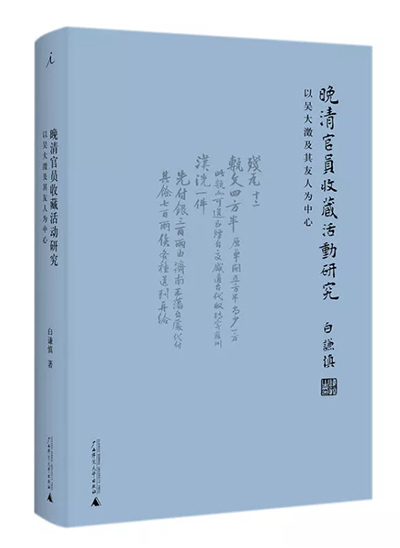How did late Qing officials influence the cultural relics market?

A Study on the Collection Activities of Officials in the Late Qing Era
In the recent wave of Chinese art history research, the cultural relics market deserves further study. Despite ample research on Xiang Yuanbian (1525–1590) and other important collectors, the price of artworks is still a difficult topic for scholars.
Restricted by insufficient documents, Bai Qianshen, dean and a professor from the School of Art and Archaeology at Zhejiang University, focuses on Chinese officials in the second half of the 18th century in his case study of Wu Dacheng (1835–1902) and Wu’s friends. In A Study on the Collection Activities of Officials in the Late Qing Era, the author tries to analyze the situation of the cultural relics market in the late Qing, the activities of officials in the market, the information and circulation mechanisms that supported collecting, and how the income of officials influenced their collecting.
In the late Qing, the market for bronze wares, calligraphy works, paintings, rubbings and other cultural relics fluctuated occasionally, but overall, it was in a state of booming development. The diaries of late Qing officials reveal that a large proportion of this group, from high-ranking officials such as Zeng Guofan (1811–1872) and Weng Tonghe (1830–1904) to low-ranking officials such as Yang Baoguang (1830–1912), were engaged in the collection of cultural relics. As officials, they enjoyed much higher incomes than average; as literati, they had strong cultural needs and desires. This meant that collecting antiques and cultural relics became a must in their daily lives.
In addition to personal cultural desires, the fact that cultural relics were regarded as gifts was another important reason for officials to participate in the market of cultural relics. For example, during the campaign against the Taiping Rebellion (1851–1864), Zuo Zongtang (1812–1885) was unjustly accused, and Pan Zuyin (1830–1890) successfully defended him. In the 1870s, in order to express his gratitude, Zuo, then governor of Shaanxi and Gansu provinces, presented Pan with the Da Yu ding, a bronze tripod vessel from the Western Zhou Dynasty (1046–771 BCE). The tripod, weighing 153.5 kilograms, was delivered from Shaanxi to Beijing by dozens of soldiers. Mobilizing official resources to aid in the running of the collection market was a feature of the collection activities of late Qing officials.
Wu Dacheng also participated in many cultural relic purchases and mobilized various official resources for his collection activities. According to preliminary statistics, the author estimates that in 1889, Wu spent between 8,500 and 10,000 silver ingots to purchase antiquities, while his income was about 35,000 silver ingots that year. Before the War of Jiawu (1894–1895), Wu’s collections including bronze and jade wares totaled nearly 6,500 pieces. These pieces were usually neither large nor heavy. Due to Wu’s unique flair, however, he eventually became a very influential jade collector in the late Qing.
Yao Yufei is from the School of Liberal Arts at Nanjing University.
edited by YANG LANLAN
